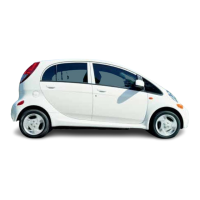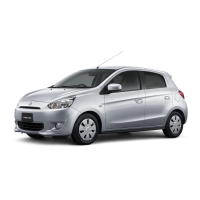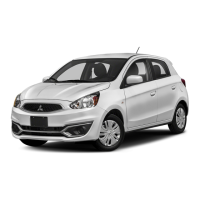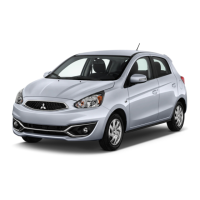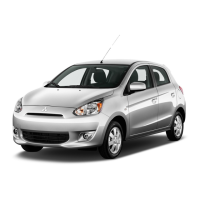3-2 Chapter 3 Cooling, heating and air conditioning systems
cold
Radiator
hot
1.2 Coolant flow with the engine cold and hot
1
General information
Refer to illustration 1.2
Engine cooling system
All vehicles covered by this manual employ a pressurized engine cool-
ing system with thermostatically controlled coolant circulation. An impel-
ler-type water pump mounted on the front of the block pumps coolant
through the engine. The coolant flows around each cylinder and toward
the rear of the engine. Cast-in coolant passages direct coolant around the
intake and exhaust ports, near the spark plug areas and in close proximity
to the exhaust valve guides.
A wax peilet-type thermostat is located in a housing near the front of
the engine. During warm-up, the closed thermostat prevents coolant from
circulating through the radiator. As the engine nears normal operating
temperature, the thermostat opens and allows hot coolant to travel
through the radiator, where it’s cooled before returning to the engine (see
Illustration).
The cooling system is sealed by a pressure type radiator cap, which
raises the boiling point of the coolant and increases the cooling efficiency
of the radiator. If the system pressure exceeds the cap pressure relief val-
ue, the excess pressure in the system forces the spring-loaded valve in-
side the cap off its seat and allows the coolant to escape through the
overflow tube into a coolant reservoir. When the system cools the excess
coolant is automatically drawn from the reservoir back into the radiator.
The coolant reservoir does double duty as both the point at which fresh
coolant is added to the cooling system to maintain the proper fluid level
and as a holding tank for overheated coolant.
This type of cooling system is known as a closed design because cool-
ant that escapes past the pressure cap is saved and reused.
Heating system
The heating system consists of a blower fan and heater core located
in the heater box, the hoses connecting the heater core to the engine cool-
ing system and the heater/air conditioning control head on the dashboard.
Hot engine coolant is circulated through the heater core. When the heater
mode is activated, a flap door opens to expose the heater box to the pas-
sengercompartment. A fan switch on the control head activates the blow-
er motor, which forces air through the core, heating the air.
Air conditioning system
The air conditioning system consists of a condenser mounted in front
of the radiator, an evaporator mounted adjacent to the heater core, a com-
pressor mounted on the engine, a receiver/drier which contains a high-
pressure relief valve and the plumbing connecting all of the above
components.
A blower fan forces the warmer air of the passenger compartment
through the evaporator core (sort of
a
radiator-in-reverse), transferring the
heat from the air to the refrigerant. The liquid refrigerant boils off into low
pressure vapor, taking the heat with it when it leaves the evaporator.
2 Antifreeze -general information
Warning:
Do not allow antifreeze to come in contact with your skin or
painted surfaces of the vehicle. Rinse off spills immediately with plenty of
wafer. /f consumed, ant/freeze can be fatal; children andpets
are attraiSd
by its sweet taste, so wipe up garage floor and drip pan coolant spikim-
mediately. Keep antifreeze containers covered and repair leaks in your
cooling system as soon as they are noticed.
Thecoolingsystemshould befilledwithawater/ethyleneglycoI-based
antifreeze solution, which will prevent freezing down to at least -20-de-
grees F, or lower if local climate requires it. It also provides protection
against corrosion and increases the coolant boiling point.
The cooling system should be drained, flushed and refilled at the speci-
fied intervals (see Chapter 1). Old or contaminated antifreeze solutions
are likely to cause damage and encourage the formation of rust and scafe
in the system. Use distilled water with the antifreeze.
Before adding antifreeze, check all hose connections, because an%-
freezetendstoleakthroughveryminuteopenings. Enginesdon’tnormtiy
consume coolant, so if the level goes down, find the cause and corre3Tt.~
The exact mixture of antifreeze-to-water which you should use de-
pends on the relative weather conditions. The mixture should contain&
least 50 percent antifreeze. but should never contain more than 70 percent
antifreeze. Consult the mixture ratio chart on the antifreeze container be-
fore adding coolant. Hydrometers are available at most auto parts stores
to testthecoolant. Use antifreeze which meets thevehicle manufacturer’s
specifications.
3 Thermostat - check and replacement
Warning:
Donotremove the radiatorcap, drain the coolantorreplace the
thermostat until the engine has cooled completely
Check
1
Before assuming the thermostat is to blame for a cooling system
problem, check the coolant level, water pump (see Section 7), drivebelt
tension (see Chapter 1) and temperature gauge (or light) operation. _~

